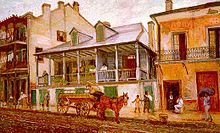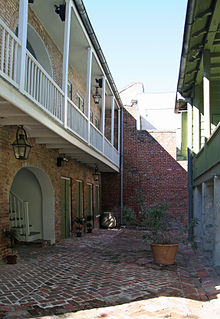- Madame John’s Legacy
-
Madame John’s Legacy ist ein historisches Bauensemble in der Dumaine Street 632 im French Quarter von New Orleans im US-Bundesstaat Louisiana.
Die Anlage besteht aus drei Teilen: dem Hauptgebäude, dem Küchengebäude mit integriertem Wohnkomplex („cook’s quarters“) für Küchenangestellte und einem ursprünglich dreistöckigen Wohngebäude (Garçonnière). Das Fundament besteht aus Backstein, die Mauern sind mit einer Holzfassade belegt. Im Innenhof wurden früher Hausarbeiten erledigt.
Die Bezeichnung „Madame John’s Legacy“ entstammt dem Roman „Tite Poulette“ des US-amerikanischen Schriftstellers George Washington Cable.[1]
Inhaltsverzeichnis
Geschichte
Das Hauptgebäude des heutigen Ensembles wurde im französischen Kolonialstil nach dem Stadtbrand von 1788 auf dem Fundament und teilweise mit dem Baumaterial eines älteren, schätzungsweise von 1722 bis 1728 stammenden Gebäudes neu errichtet. Es überstand den neuerlichen Stadtbrand von 1794. In der Folgezeit wechselte es oft den Besitzer und wurde mehrfach umgebaut, die heutigen Stallungen wurden 1826 errichtet, die Garçonnière im Jahr 1845. Im späten 19. Jahrhundert wurden in allen Gebäudeteilen Wohnungen eingerichtet. Die letzten Besitzer stifteten die Gebäude 1947 dem Louisiana State Museum. Im Jahr 1952 beschädigte ein Hurrikan die Garçonnière, das oberste Stockwerk wurde nicht wieder aufgebaut. Bis 1965 war das Haus als Museum zugänglich, dann wurde es abermals bei einem Hurrikan stark beschädigt. Die Restaurierungsarbeiten begannen erst 1974 und wurden ein Jahr später abgeschlossen. Seitdem dient das Haupthaus, das eines der besterhaltenen Gebäude aus dem New Orleans des 18. Jahrhunderts darstellt, wieder als Museum. Im Jahre 1998 wurde das Anwesen erneut saniert.
Madame John’s Legacy wurde am 15. April 1970 vom National Register of Historic Places mit der Nummer 70000256 aufgenommen und wegen seiner prägenden kreolischen Architektur als National Historic Landmark eingetragen. [2] [3] [4][5] [6] [7]
Trivia
Das Haus diente als Kulisse und Schauplatz in dem Film Interview mit einem Vampir.[8]
Weblinks
-
 Commons: Madame John’s Legacy – Sammlung von Bildern, Videos und Audiodateien
Commons: Madame John’s Legacy – Sammlung von Bildern, Videos und Audiodateien - USGS topographic map: New Orleans East, LA
Einzelnachweise
- ↑ Louisiana State Museum: How Madame John’s Got Its Name
- ↑ National Register of Historic Places Inventory-Nomination: Madame John’s Legacy
- ↑ 4 Fotos, aus dem Jahr 1975, von außen
- ↑ NRIS
- ↑ National Historic Landmarks Program (NHL)
- ↑ Louisiana State Museum Madame John’s Legacy
- ↑ File:MadamJohnsLegacyPlaques.jpg - Wikimedia Commons
- ↑ Mary Herczog: Frommer’s New Orleans 2008, S. 208–, Frommer’s 26 December 2007, ISBN 9780470194065 (Zugriff am 4 February 2011)
29.959444444444-90.062777777778Koordinaten: 29° 57′ 34″ N, 90° 3′ 46″ WKategorien:- Denkmal im National Register of Historic Places (Louisiana)
- National Historic Landmark (Louisiana)
- Museum in den Vereinigten Staaten
- Bauwerk in Louisiana
-
Wikimedia Foundation.



